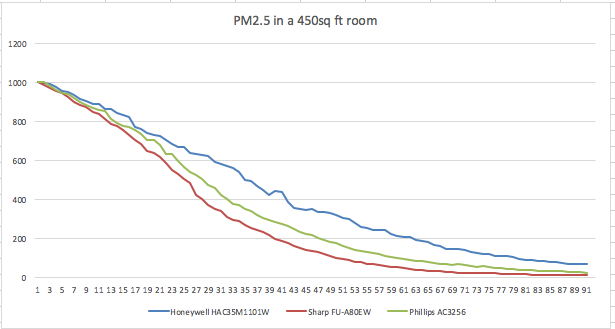6 Things You Need To Know When Buying An Air Purifier [STUDY]
Many people have asked us our views on which purifiers are most effective. So we decided to use the Airveda monitor to do a small study on 3 popular Air Purifiers:

Nasal congestion or stuffy nose is the blockage of the nasal passages usually due to membranes, lining the nose, becoming swollen from inflamed blood vessels. Typical symptoms of nasal congestion are nasal discharge, congestion, cough, fever, headache, watery eyes, fever, loss of smell etc. There can be many reasons for stuffy nose like cold temperature or weather, anxiety, lack of sleep, nasal polyps, pollution, dust, allergens, deviated septum, chronic sinus problems etc.
Some 6-Things-You-Need-To-Know-When-Buying-An-Air-Purifier-STUDYn:
KEY TAKE AWAYS FROM OUR STUDY
- What levels of filtration are needed?: Given high PM2.5 concentrations in India, it is essential to buy a purifier with a HEPA filter which protects you against very small PM2.5 particles. You also need a pre-filter which catches the bigger particles preventing the HEPA from getting clogged quickly. Additional levels of filtration are nice to have.
- Which specification of the purifier is most important?: The Association of Home Appliance Manufacturers (AHAM) developed the CADR, otherwise known as the “Clean Air Delivery Rate”. Based on our study, CADR is the best metric to determine the effectiveness of a purifier. If you are trying to pick between a few purifiers of the same cost, go with the one with the higher CADR.
-
How does CADR translate into room size?:
AHAM recommends that filters should be used in rooms whose volumes, expressed in cubic feet, are equal or smaller than the filter’s CADR rating multiplied by 12. Assuming the height of the room to be 8ft:
- For an 818 sq ft room, CADR should be at least 545 (818*8/12).
- For a 680 sq ft room, CADR should be at least 453 (680*8/12).
- For a 450 sq ft room, CADR should be at least 300 (450*8/12).
- For a 200 sq ft room, CADR should be at least 134 (200*8/12).
- Do AHAM prescribed CADR work well for India?: The prescribed values by AHAM are absolute minimum. In our study, we saw that in a 450 sq ft room with a purifier with CADR 300, it took an hour to reduce the room's PM2.5 from 300 μg/m³ to under 30 μg/m³. AHAM prescribes these numbers for less polluted spaces than we have in India. We recommend getting a purifier with CADR at least 50-100 above the minimum prescribed value per the AHAM formula above.
- What CADR will work for my room space?: The effectiveness of a purifier depends on the room size and leakage. For larger rooms or rooms with high leakage, you will need a purifier with higher CADR or multiple purifiers. The best way to determine effectiveness is to measure levels in the room with an air quality monitor after the purifier has been running for at least 30 minutes. Also, note that the specified CADR is based on the purifier running at the highest speed. If you run your purifier on 'auto' or at lower speeds, you will not see the same level of effectiveness.
- How accurate are the inbuilt air quality indicators on the purifiers?: We found that both Sharp and Honeywell indicators were unreliable—the colors did not match the levels of pollution. Phillips has a sensor that shows PM2.5 numbers, but the numbers and trends were inaccurate. Ask your dealer to send a salesperson with an independent monitor to ensure the purifier is effective, or better yet, buy an air quality monitor.
STUDY DETAILS
Setup:
- Room-size: 450 sqft. This was the lowest claimed by the three purifiers.
- Leakage: Room had no windows and a well-sealed heavy door, so leakage was low.
- Purifier condition: All purifiers were new with original company filters.
- Data: Each purifier was tested individually in the same 450 sqft room by creating pollution levels using Dhoop and Agarbatti up to PM2.5 of 999 and then turning on the purifier, letting pollution levels drop.
Findings:
a) Below is the amount of time taken by the three purifiers to clean the room:

PM2.5 trends with the three purifiers.
Details in tabular form:

b) Time taken to clean the room was directly proportional to the purifiers’ CADR.
The Association of Home Appliance Manufacturers (AHAM) developed the CADR, otherwise known as the “Clean Air Delivery Rate”. This helps you identify how quick and efficient your potential air cleaner is.

The 2.7 simply means that AHAM tested in a cleaner environment. But more importantly, the time taken to clean the room is directly proportional to the CADR in an almost exact way. This implies that CADR prescribed by these purifiers is quite accurate and is by far the best metric to determine how effective a purifier will be.
We hope this study will help you in your next purifier purchase. Do provide feedback on this post, as well as other studies you would like to see in the comments below. If you found this study useful then do share it on your timeline.
Disclaimer: This post is not an endorsement from AIRVEDA for any of the brands. Our insights are based solely on this study, and we do not make any claims about the performance of these or any other purifiers outside this study.

